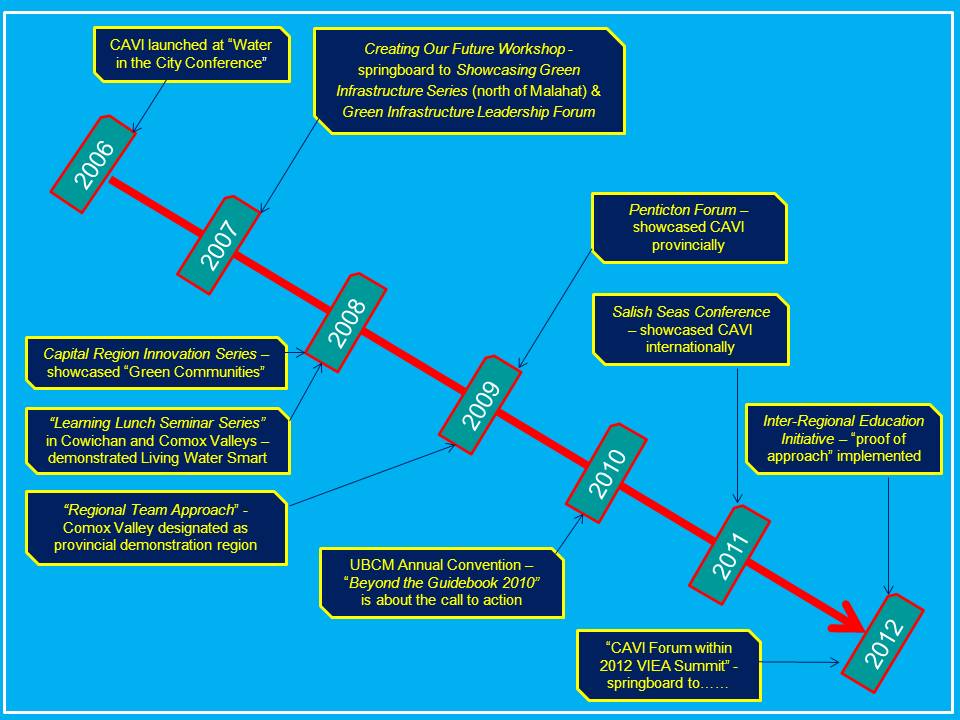CAVI Story: Leadership in Water Sustainability (Hour #1 Panel)
Note to Reader:
On October 15 in Nanaimo, the “CAVI Forum within the VIEA Summit” will look back at what has been accomplished by the CAVI initiative over the past six years and look ahead to paint a picture of settlement, ecology and economy in balance. The story below previews the “CAVI timeline” that will be presented in Hour #1.
To download a PDF copy of the image below, click on CAVI timeline for period 2006 through 2012. And to download a copy of the Forum Agenda, click here.
Move from Awareness to Action
CAVI is the acronym for Convening for Action on Vancouver Island. Launched in 2006 at the Water in the City Conference, CAVI is an initiative of the Partnership for Water Sustainability in British Columbia, a not-for-profit society. The CAVI program is being delivered under the umbrella of the Water Sustainability Action Plan for British Columbia.
From 2007 through 2011, the Province and Real Estate Foundation co-funded CAVI as a provincial demonstration initiative to develop local government talent. The CAVI program is sustained by the commitment of the Partnership leadership team and the hands-on involvement of Vancouver Island local government staff.
 “The CAVI timeline (refer to image above) identifies defining moments. It has been a building block process. Success begets success,” reports Kim Stephens, Partnership Executive Director and Forum facilitator. “A key to that success has been our inclusive and adaptive approach. We have always recognized the power of a conversation and the power of listening. From the get-go, our goal was to build a support network for the champions in local government.”
“The CAVI timeline (refer to image above) identifies defining moments. It has been a building block process. Success begets success,” reports Kim Stephens, Partnership Executive Director and Forum facilitator. “A key to that success has been our inclusive and adaptive approach. We have always recognized the power of a conversation and the power of listening. From the get-go, our goal was to build a support network for the champions in local government.”
The Hour #1 Panel
In Hour #1, a panel of five will bring to life the defining moments along the timeline for the period 2006 through 2012. Each has made significant and timely contributions that ensured the ultimate success of the CAVI initiative. Briefly:
-
TIM PRINGLE was instrumental in getting the CAVI initiative off the ground. As the Executive Director of the Real Estate Foundation (REFBC), he was the architect of the initial 3-year funding commitment by the REFBC that made the initiative possible. This was the key to leveraging matching funding from two provincial Ministries – Environment and Community Services.
-
KATE MILLER attended the CAVI launch in September 2006, caught the spirit, and was an early champion for the initiative. Her support was key to CAVI establishing a ‘beach-head’ in the Cowichan Valley. Her vision made it possible to implement, in 2008, the first of the Vancouver Island Learning Lunch Seminar Series. This provided a springboard that led to other successes
-
JODY WATSON was also at the CAVI launch in 2006. As Chair of the Bowker Creek Initiative, Jody is a driving force behind the Bowker Creek Blueprint. It is a 100-year action plan to restore watershed function in the urban heartland of the Capital Region. The Bowker Blueprint is provincially significant and precedent-setting. It is inspiring and/or influencing what is happening elsewhere on the Island and in other parts of British Columbia.
-
PETER LAW chaired the inter-governmental steering committee that was responsible for Stormwater Planning: A Guidebook for British Columbia, released in 2002. As an outcome of Peter Law’s leadership, the Guidebook is recognized internationally as being a catalyst for a ‘design with nature’ approach to achieving water sustainability through implementation of green infrastructure policies and practices.
-
DEREK RICHMOND is another who caught the ‘CAVI spirit’ at the 2006 launch. He has been a driving force behind the CAVI-Comox Valley Regional Team, and is the current CAVI Chair. “If we do things right at the front-end, the end result will be a lot better, and everyone will save time and money. The end product will be value-added,” says Derek.
The vignetttes that the Hour #1 Panel will share on October 15 epitomize what is involved in moving from awareness (talk) to action (practice).
CAVI has brought together four regions as partners in an Inter-Regional Education Initiative
“Collaboration is the pathway to a consistent approach to water sustainability and green infrastructure policies and practices up and down the east coast of Vancouver Island. The Inter-Regional Education Initiative, IREI, will help all regions bridge the ‘implementation and integration gap’,” states Peter Law. Formerly with the Ministry of Environment, he is a founding Director of the Partnership for Water Sustainability in British Columbia.
Beyond the Guidebook
“Four regional boards – Comox Valley, Nanaimo Region, Cowichan Valley and Capital Region – have formally endorsed the IREI, in large part because a guiding principle is that program elements will align with local government priorities and staff workloads. And a program goal is that local governments will leverage more with the same resources. These four regional districts represent 90% of the Vancouver Island population.”
“At the heart of the IREI are program modules that are branded as being ‘Beyond the Guidebook’ because they integrate the tools and understanding that build on the technical foundation provided by the Guidebook. The premise underpinning the Guidebook is that land development and watershed protection can be compatible. The basis for this premise is that municipalities exert control over runoff volume through their land development and infrastructure policies, practices and actions,” concludes Peter Law.




